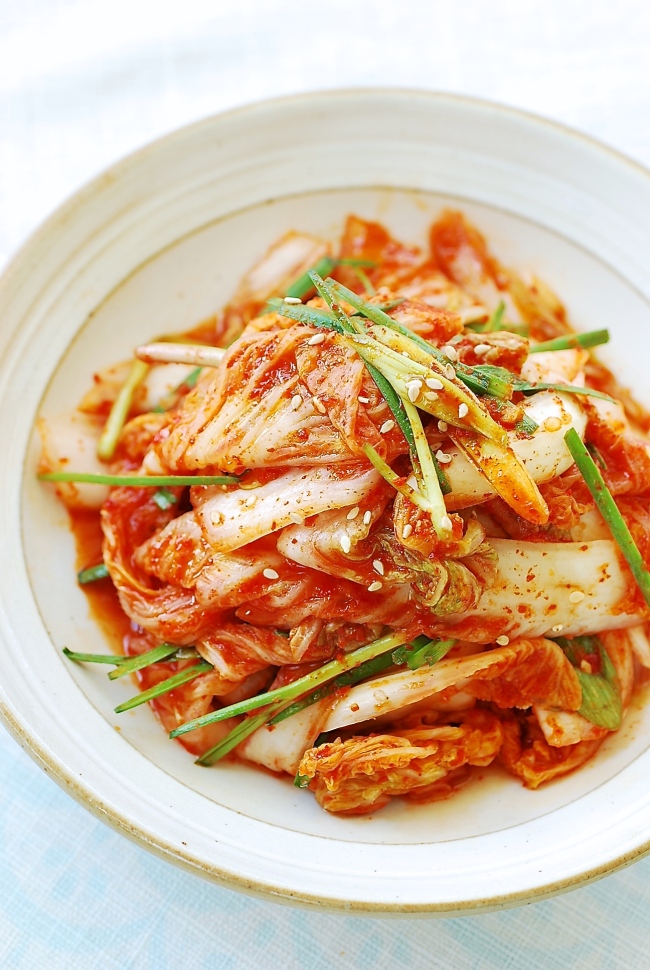Geotjeori is basically a kimchi that’s made to be eaten fresh without fermentation. As such, the vegetables are lightly salted. Geot means outer or outside, and jeori means salted or pickled. Most commonly made with napa cabbage, geotjeori goes especially well with dishes such as kalguksu (a warm noodle soup) and barbecued meat.
Because it’s eaten without fermentation, during which a natural sweetness develops, the addition of sugar or corn syrup (or Korean rice syrup) helps round out the flavor of geotjeori. In this recipe, I also used a Korean plum extract called maesil cheong, which adds a natural fruity sweetness.
Ingredients:
1 small baechu (napa cabbage), about 1 kilogram
4 tablespoons coarse sea salt (less if using finer salt)
2 scallions, roughly chopped
80 grams buchu (garlic chives), cut into 5-centimeter pieces
Few stalks minari (water dropwort), cut into 5-centimeter pieces
Seasoning:
4 tablespoons gochugaru
3 tablespoons fish sauce
1 tablespoon corn syrup (or Korean rice syrup)
1 tablespoon maesil cheong (Korean plum extract)
1 tablespoon minced garlic
1 teaspoon grated ginger
1 teaspoon sesame seeds

Because it’s eaten without fermentation, during which a natural sweetness develops, the addition of sugar or corn syrup (or Korean rice syrup) helps round out the flavor of geotjeori. In this recipe, I also used a Korean plum extract called maesil cheong, which adds a natural fruity sweetness.
Ingredients:
1 small baechu (napa cabbage), about 1 kilogram
4 tablespoons coarse sea salt (less if using finer salt)
2 scallions, roughly chopped
80 grams buchu (garlic chives), cut into 5-centimeter pieces
Few stalks minari (water dropwort), cut into 5-centimeter pieces
Seasoning:
4 tablespoons gochugaru
3 tablespoons fish sauce
1 tablespoon corn syrup (or Korean rice syrup)
1 tablespoon maesil cheong (Korean plum extract)
1 tablespoon minced garlic
1 teaspoon grated ginger
1 teaspoon sesame seeds

Separate the cabbage leaves. Cut each leaf lengthwise, and then cut crosswise once or twice into long bite sizes. Rinse in water and drain.
Place a layer of cabbage in a large bowl and sprinkle with a tablespoon of salt. Repeat with the remaining cabbage and salt. Toss well to coat evenly. Leave it for 40 to 60 minutes until softened, tossing once halfway through.
Combine all the seasoning ingredients in a small bowl, and mix well with 2 tablespoons of water.
Rinse the cabbage twice and drain well.
Add the seasoning mix to the cabbage. Using a kitchen glove, toss everything by hand until the cabbage pieces are well coated with the seasoning. Add the scallion, minari and buchu. Add a little salt or more fish sauce to taste.
For more recipes visit www.koreanbapsang.com.
By Ro Hyo-sun
Place a layer of cabbage in a large bowl and sprinkle with a tablespoon of salt. Repeat with the remaining cabbage and salt. Toss well to coat evenly. Leave it for 40 to 60 minutes until softened, tossing once halfway through.
Combine all the seasoning ingredients in a small bowl, and mix well with 2 tablespoons of water.
Rinse the cabbage twice and drain well.
Add the seasoning mix to the cabbage. Using a kitchen glove, toss everything by hand until the cabbage pieces are well coated with the seasoning. Add the scallion, minari and buchu. Add a little salt or more fish sauce to taste.
For more recipes visit www.koreanbapsang.com.
By Ro Hyo-sun








![[KH Explains] Hyundai's full hybrid edge to pay off amid slow transition to pure EVs](http://res.heraldm.com/phpwas/restmb_idxmake.php?idx=644&simg=/content/image/2024/04/18/20240418050645_0.jpg&u=20240419100350)






![[From the Scene] Monks, Buddhists hail return of remains of Buddhas](http://res.heraldm.com/phpwas/restmb_idxmake.php?idx=652&simg=/content/image/2024/04/19/20240419050617_0.jpg&u=20240419175937)

![[KH Explains] Hyundai's full hybrid edge to pay off amid slow transition to pure EVs](http://res.heraldm.com/phpwas/restmb_idxmake.php?idx=652&simg=/content/image/2024/04/18/20240418050645_0.jpg&u=20240419100350)

![[Today’s K-pop] Illit drops debut single remix](http://res.heraldm.com/phpwas/restmb_idxmake.php?idx=642&simg=/content/image/2024/04/19/20240419050612_0.jpg&u=)